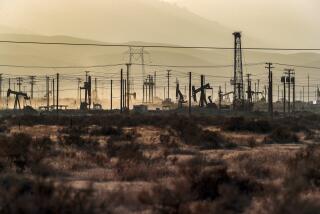EPA approves city’s plan to bury sludge
- Share via
Los Angeles has a plan for getting rid of some of the city’s sewage sludge that nobody wants in their backyard -- bury it a mile below Terminal Island in a sandstone formation.
In what is believed to be the first project of its kind, the city has won federal environmental approval for a five-year experiment to inject as much as 400 tons of treated sewage sludge a day into a depleted oil field deep in the Earth.
If successful, officials said, the program could become not only a national model but would give Los Angeles more ways to dispose of one of its least desirable products.
Virtually all of the city’s treated sewage sludge now goes to a city-owned farm in Kern County, where voters issued an emphatic return-to-sender statement earlier this year when they approved a ballot measure that banned the sludge dumping. The move was put on hold by the courts, but the city wants to develop other options.
“For many years, we’ve been putting too many eggs in one basket and it’s ultimately our intent to diversify our program to the best we can,” said Omar Moghaddam, regulatory affairs manager for the city’s public works department.
Oil companies have long disposed of oil field waste by injection drilling. But, Moghaddam said, this will mark the first time that treated human waste will be pumped so far below ground.
The sludge, which will be mixed with treated wastewater to produce a slurry, will seep into porous sandstone and decompose, producing methane gas and carbon dioxide. The methane would be extracted to produce energy for the sewage treatment plant on Terminal Island and the carbon dioxide would remain sequestered below ground, reducing emissions of a greenhouse gas.
All in all, it could be an environmental trifecta.
“We are very excited about it. It is a project that has been in the works for a number of years,” said David Albright, a regional manager with the U.S. Environmental Protection Agency, which recently issued a permit to the city to conduct the experiment. “It is a very sophisticated project. We certainly feel like the time has come to test this technology.”
Albright said there was no significant opposition to the EPA permit, which the city applied for in 2001.
Deep-well injections can pose a threat to groundwater, but Albright said there would be no fresh water at that depth. The injection would occur at least half a mile below the nearest water table, Moghaddam said, and that is contaminated with saltwater.
In addition to the injection well, which would be lined with a metal casing, the city will operate two monitoring wells.
If successful, Moghaddam said, the process could be used in depleted oil fields anywhere. “This very much can be a showcase for the entire nation,” he said.
The methane could produce enough energy to power 3,500 homes, while the carbon sequestration would cut carbon emissions by 81,000 tons a year, he said.
Los Angeles sewage treatment plants produce about 730 tons a day of sludge, which is trucked to the city’s Green Acres farm 15 miles southwest of Bakersfield. There it is tilled into the soil and used to grow forage crops for dairy cattle.
*
More to Read
Sign up for Essential California
The most important California stories and recommendations in your inbox every morning.
You may occasionally receive promotional content from the Los Angeles Times.











